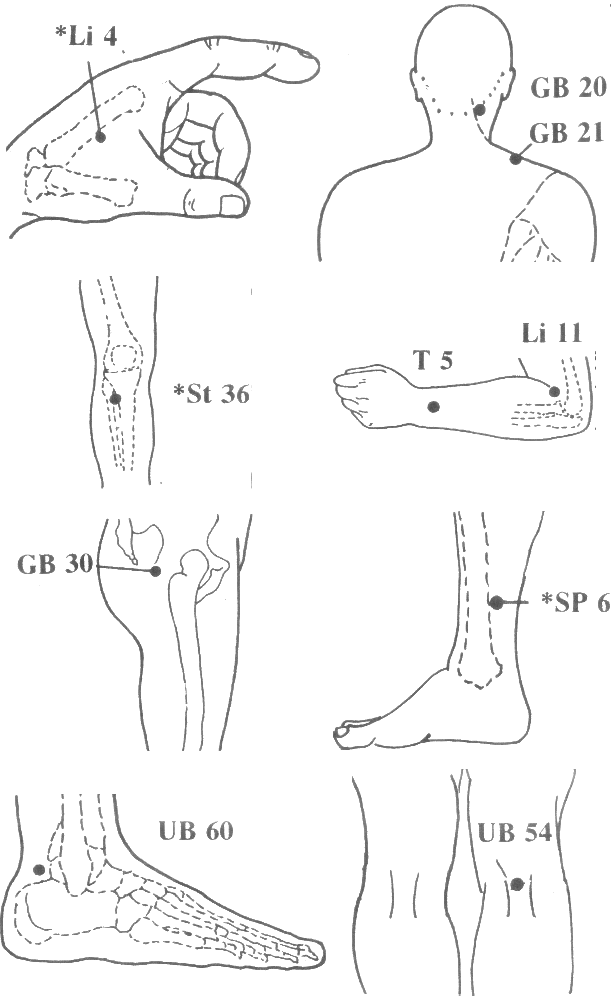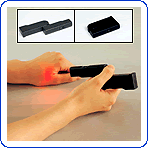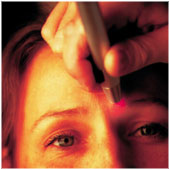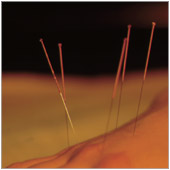OCCUPATIONAL THERAPY




Acupuncture (from Lat. acus, "needle" (noun), and pungere, "prick" (verb)) or in Standard Mandarin, zhēn jiǔ (lit: needle - moxibustion) is a technique of inserting and manipulating needles into "acupuncture points" on the body. According to acupunctural teachings this will restore health and well-being, and is particularly good at treating pain. The definition and characterization of these points is standardized by the World Health Organization [1] (WHO). Acupuncture is thought to have originated in China and is most commonly associated with Traditional Chinese medicine (TCM). Other types of acupuncture (Japanese, Korean, and classical Chinese acupuncture) are practiced and taught throughout the world.
Whether acupuncture is efficacious or a placebo has been the subject of ongoing scientific research. Scientists have conducted reviews of existing clinical trials according to the protocols of evidence-based medicine; some have found efficacy for headache, low back pain and nausea, but for most conditions have concluded that there is insufficient evidence to determine whether or not acupuncture is effective. The WHO, the National Center for Complementary and Alternative Medicine (NCCAM) of the National Institute of Health (NIH), the American Medical Association (AMA) and various government reports have also studied and commented on the efficacy of acupuncture. There is general agreement that acupuncture is safe when administered by well-trained practitioners, and that further research is warranted.
Traditional Chinese medicine's acupuncture theory predates use of the scientific method, and has received various criticisms based on scientific thinking. There is no physically verifiable anatomical or histological basis for the existence of acupuncture points or meridians. Proponents reply that TCM is a prescientific system that continues to have practical relevance. Acupuncturists tend to perceive TCM concepts in functional rather than structural terms, i.e. as being useful in guiding evaluation and care of patients
Traditional theory:
Chinese medicine is based on a different paradigm than scientific biomedicine. Its theory holds the following explanation of acupuncture:
Acupuncture treats the human body as a whole that involves several "systems of function" that are in some cases loosely associated with (but not identified on a one-to-one basis with) physical organs. Some systems of function, such as the "triple heater" (San Jiao, also called the "triple burner") have no corresponding physical organ. Disease is understood as a loss of homeostasis among the several systems of function, and treatment of disease is attempted by modifying the activity of one or more systems of function through the activity of needles, pressure, heat, etc. on sensitive parts of the body of small volume traditionally called "acupuncture points" in English, or "xue" (cavities) in Chinese. This is referred to as treating "patterns of disharmony".
Treatment of acupuncture points may be performed along the twelve main or eight extra meridians, located throughout the body, or on tender points, called "ashi" (signifying "that's it", "ouch", or "oh yes"). Of the eight extra meridians, only two have acupuncture points of their own. The other six meridians are "activated" by using a master and couple point technique which involves needling the acupuncture points located on the twelve main meridians that correspond to the particular extra meridian. Ten of the main meridians are named after organs of the body (Heart, Liver, etc.), and the other two are named after so called body functions (Heart Protector or Pericardium, and San Jiao). The meridians are capitalized to avoid confusion with a physical organ (for example, we write the "Heart meridian" as opposed to the "heart meridian"). The two most important of the eight "extra" meridians are situated on the midline of the anterior and posterior aspects of the trunk and head. The twelve primary meridians run vertically, bilaterally, and symmetrically and every channel corresponds to and connects internally with one of the twelve Zang Fu ("organs"). This means that there are six yin and six yang channels. There are three yin and three yang channels on each arm, and three yin and three yang on each leg.
The three yin channels of the hand (Lung, Pericardium, and Heart) begin on the chest and travel along the inner surface (mostly the anterior portion) of the arm to the hand.
The three yang channels of the hand (Large intestine, San Jiao, and Small intestine) begin on the hand and travel along the outer surface (mostly the posterior portion) of the arm to the head.
The three yang channels of the foot (Stomach, Gallbladder, and Bladder) begin on the face, in the region of the eye, and travel down the body and along the outer surface (mostly the anterior and lateral portion) of the leg to the foot.
The three yin channels of the foot (Spleen, Liver, and Kidney) begin on the foot and travel along the inner surface (mostly posterior and medial portion) of the leg to the chest or flank.
The movement of qi through each of the twelve channels is comprised of an internal and an external pathway. The external pathway is what is normally shown on an acupuncture chart and it is relatively superficial. All the acupuncture points of a channel lie on its external pathway. The internal pathways are the deep course of the channel where it enters the body cavities and related Zang-Fu organs. The superficial pathways of the twelve channels describe three complete circuits of the body.
The distribution of qi through the meridians is said to be as follows: Lung channel of hand taiyin to Large Intestine channel of hand yangming to Stomach channel of foot yangming to Spleen channel of foot taiyin to Heart channel of hand shaoyin to Small Intestine channel of hand taiyang to Bladder channel of foot taiyang to Kidney channel of foot shaoyin to Pericardium channel of hand jueyin to San Jiao channel of hand shaoyang to Gallbladder channel of foot shaoyang to Liver channel of foot jueyin then back to the Lung channel of hand taiyin.
Chinese medical theory holds that acupuncture works by normalizing the free flow of qi (a difficult-to-translate concept that pervades Chinese philosophy and is commonly translated as "vital energy") throughout the body. Pain or illnesses are treated by attempting to remedy local or systemic accumulations or deficiencies of qi. Pain is considered to indicate blockage or stagnation of the flow of qi, and an axiom of the medical literature of acupuncture is "no pain, no blockage; no blockage, no pain".
Many patients claim to experience the sensations of stimulus known in Chinese as "deqi" "obtaining the qi" or "arrival of the qi"). This kind of sensation was historically considered to be evidence of effectively locating the desired point. There are some electronic devices now available which will make a noise when what they have been programmed to describe as the "correct" acupuncture point is pressed.
The acupuncturist decides which points to treat by observing and questioning the patient in order to make a diagnosis according to the tradition which he or she utilizes. In TCM, there are four diagnostic methods: inspection, auscultation and olfaction, inquiring, and palpation (Cheng, 1987). Inspection focuses on the face and particularly on the tongue, including analysis of the tongue size, shape, tension, color and coating, and the absence or presence of teeth marks around the edge. Auscultation and olfaction refer, respectively, to listening for particular sounds (such as wheezing) and attending to unusual body odor. Inquiring focuses on the "seven inquiries", which are: chills and fever; perspiration; appetite, thirst and taste; defecation and urination; pain; sleep; and menses and leukorrhea. Palpation includes feeling the body for tender "ashi" points, and palpation of the left and right radial pulses at two levels of pressure (superficial and deep) and three positions (immediately proximal to the wrist crease, and one and two fingers' breadth proximally, usually palpated with the index, middle and ring fingers). Other forms of acupuncture employ additional diagnosic techniques. In many forms of classical Chinese acupuncture, as well as Japanese acupuncture, palpation of the muscles and the hara (abdomen) are central to diagnosis.
There are also theories being developed to explain effects observed for acupuncture within the orthodox Western medical paradigm.
Categories of acupuncture points
Certain acupuncture points are ascribed different functions according to different systems within the TCM framework.
Five Transporting Points system describes the flow of qi in the channels using a river analogy, and ascribes function to points along this flowline according to their location. This system describes qi bubbling up from a spring and gradually growing in depth and breadth like a river flowing down from a mountain to the sea.
Jing-well points represent the place where the qi "bubbles" up. These points are always the first points on the yang channels or last points on the yin channels and with exception of Kid-1 YongQuan all points are located on the tips of fingers and toes. The Nan Jing and Nei Jing described jing-well points as indicated for "fullness below the heart" (feeling of fullness in the epigastric or hypochondrium regions) and disorders of the zang organs (yang organs).
Ying-spring points are where the qi "glides" down the channel. The Nan Jing and Nei Jing described ying-spring points as indicated for heat in the body and change in complexion.
Shu-stream points are where the qi "pours" down the channel. Shu-stream points are indicated for heaviness in the body and pain in the joints, and for intermittent diseases.
Jing-river points are where the qi "flows" down the channel. Jing-river points are indicated for cough and dyspnoea, chills and fever, diseases manifesting as changes in voice, and for diseases of the sinews and bones.
He-sea points are where the qi collects and begins to head deeper into the body. He-sea points are indicated for counterflow qi and diarrhea, and for disorders resulting from irregular eating and drinking.
Five Phase Points ascribe each of the five phases - wood, fire, earth, metal and water - to one of the Five Transporting points. On the yin channels, the jing-well points are wood points, the ying-spring points are fire, shu-stream points are earth, jing-river points are metal, he-sea points are water points. On the yang channels, the jing-well points are metal, ying-spring are water, shu-stream are wood, jing-river points are fire and he-sea points are earth points. These point categories are then implemented according to Five Phase theory in order to approach the treatment of disease.
Xi-cleft points are the point on the channel where the qi and blood gather and plunge more deeply. These points are indicated in acute situations and for painful conditions.
Yuan-source points are points on the channel from where the yuan qi can be accessed.
Luo-connecting points are located at the point on the channel where the luo meridian diverges. Each of the twelve meridians have a luo point that diverges from the main meridian. There are also three extra luo channels that diverge at Sp-21, Ren-15 and Du-1.
Back-shu points lie on the paraspinal muscles either side of the spine. Theory says that the qi of each organ is transported to and from these points, and can be influenced by them.
Front-mu points are located in close proximity to the respective organ. They have a direct effect on the organ itself but not on the associated channel.
Hui-meeting points are a category of points that are considered to have a "special effect" on certain tissues and organs.
The hui-meeting points are:
zang organs - Liv-13 Zhang Men
fu organs - Ren-12 Zhong Fu
qi - Ren-17 Shang Fu
blood - Bl-17 Ge Shu
sinews - GB-34 Yang Ling Quan
vessels - Lu-9 Tai Yuan
bone - Bl11 Da Zhu
marrow - GB-39 Xuan Zhong
TCM perspective on treatment of disease
Although TCM is based on the treatment of "patterns of disharmony" rather than biomedical diagnoses, practitioners familiar with both systems have commented on relationships between the two. A given TCM pattern of disharmony may be reflected in a certain range of biomedical diagnoses: thus, the pattern called Deficiency of Spleen Qi could manifest as chronic fatigue, diarrhea or uterine prolapse. Likewise, a population of patients with a given biomedical diagnosis may have varying TCM patterns. These observations are encapsulated in the TCM aphorism "One disease, many patterns; one pattern, many diseases". (Kaptchuk, 1982)
Acupuncture has been used to treat a number of conditions (see Clinical practice, below). Classically, in clinical practice, acupuncture treatment is typically highly-individualized and based on philosophical constructs, and subjective and intuitive impressions" and not on controlled scientific research."